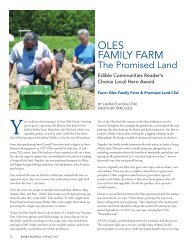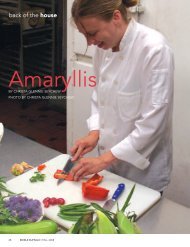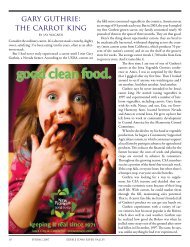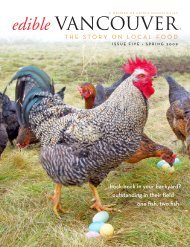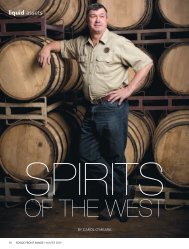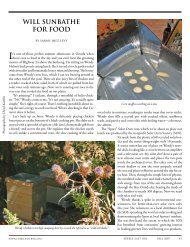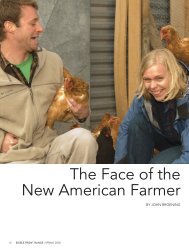The pleasure of eating - Edible Communities
The pleasure of eating - Edible Communities
The pleasure of eating - Edible Communities
You also want an ePaper? Increase the reach of your titles
YUMPU automatically turns print PDFs into web optimized ePapers that Google loves.
From these advertisements<br />
...one would not know that the various edibles<br />
were ever living creatures, or that they all come from the soil,<br />
or that they were produced by work.<br />
(just like your mother) beg you to eat it. That they do not yet <strong>of</strong>fer to<br />
insert it, prechewed, into our mouth is only because they have found<br />
no pr<strong>of</strong>itable way to do so. We may rest assured that they would be<br />
glad to find such a way. <strong>The</strong> ideal industrial food consumer would be<br />
strapped to a table with a tube running from the food factory directly<br />
into his or her stomach.<br />
Perhaps I exaggerate, but not by much. <strong>The</strong> industrial eater no<br />
longer knows or imagines the connections between <strong>eating</strong> and the<br />
land, and is therefore passive and uncritical —in short, a victim. When<br />
food, in the minds <strong>of</strong> eaters, is no longer associated with farming and<br />
with the land, the eaters suffer a kind <strong>of</strong> cultural amnesia that is<br />
misleading and dangerous.<br />
Like industrial sex, industrial <strong>eating</strong> has become a degraded, poor,<br />
and paltry thing. Our kitchens and other <strong>eating</strong> places more and more<br />
resemble filling stations, as our homes more and more resemble<br />
motels. “Life is not very interesting,” we seem to have decided. “Let its<br />
satisfactions be minimal, perfunctory, and fast.” We hurry through our<br />
meals to go to work and hurry through our work in order to “recreate”<br />
ourselves in the evenings and on weekends. And all this is carried out<br />
in a remarkable obliviousness to the causes and effects, the possibilities<br />
and the purposes, <strong>of</strong> the life <strong>of</strong> the body in this world.<br />
One will find this obliviousness represented in virgin purity in<br />
the advertisements <strong>of</strong> the food industry, in which food wears as<br />
much makeup as the actors. If one gained one’s whole knowledge <strong>of</strong><br />
food from these advertisements (as some presumably do), one would<br />
not know that the various edibles were ever living creatures, or that<br />
they all come from the soil, or that they were produced by work. <strong>The</strong><br />
passive American consumer, sitting down to a meal <strong>of</strong> pre-prepared<br />
food, confronts inert, anonymous substances that have been<br />
processed, dyed, breaded, sauced, gravied, ground, pulped, strained,<br />
blended, prettified, and sanitized beyond resemblance to any part <strong>of</strong><br />
any creature that ever lived. <strong>The</strong> products <strong>of</strong> nature and agriculture<br />
have been made, to all appearances, the products <strong>of</strong> industry. Both<br />
eater and eaten are thus in exile from biological reality. And the<br />
result is a kind <strong>of</strong> solitude, unprecedented in human experience, in<br />
which the eater may think <strong>of</strong> <strong>eating</strong> as, first, a purely commercial<br />
transaction between him and a supplier and then as a purely<br />
appetitive transaction between him and his food.<br />
And this peculiar specialization <strong>of</strong> the act <strong>of</strong> <strong>eating</strong> is, again, <strong>of</strong><br />
obvious benefit to the food industry, which has good reasons to<br />
obscure the connection between food and farming. It would not do for<br />
the consumer to know that the hamburger she is <strong>eating</strong> came from a<br />
steer who spent much <strong>of</strong> his life standing deep in his own excrement<br />
in a feedlot, helping to pollute the local streams, or that the calf that<br />
yielded the veal cutlet on her plate spent its life in a box in which it<br />
did not have room to turn around. And, though her sympathy for the<br />
slaw might be less tender, she should not be encouraged to meditate<br />
on the hygienic and biological implications <strong>of</strong> mile-square fields <strong>of</strong><br />
cabbage, for vegetables grown in huge monocultures are dependent on<br />
toxic chemicals—just as animals in close confinements are dependent<br />
on antibiotics and other drugs.<br />
<strong>The</strong> consumer, that is to say, must be kept from discovering that,<br />
in the food industry—as in any other industry—the overriding<br />
concerns are not quality and health, but volume and price. For decades<br />
the entire industrial food economy has been obsessed with volume. It<br />
has relentlessly increased scale in order (probably) to reduce costs. But<br />
as scale increases, diversity declines; so does health; and dependence on<br />
Photo by Gary L. Howe<br />
24 <strong>Edible</strong> Grande Traverse / Spring 2008 ediblegrandetraverse.com



